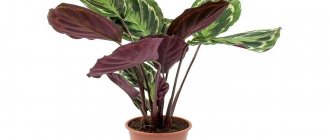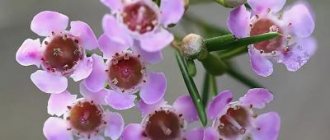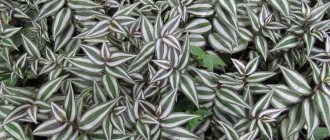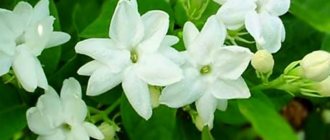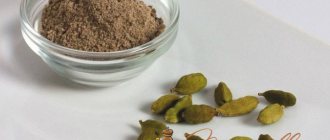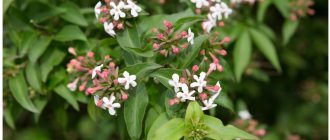Description of the plant
The genus Calathea (lat. Calathea) is the largest in the arrowroot family. Under natural conditions, this plant is found in the tropical rainforests of South and Central America. There are more than 130 wild species of calathea, but most often no more than 20 of them are grown indoors.
The flower got its name from the ancient Greek calathos - basket, because baskets have been woven from dry calathea stems from ancient times to the present day.
Calathea is a perennial ornamental deciduous plant with underground rhizomes that form a superficial root system. Vertical shoots with rosettes of leaves extend from the rhizomes, and one rosette can contain only one fully developed leaf. The leaf blades are on long vertical petioles from 30 to 80 cm in height. The leaves are large, up to 30 cm, oval, although there are also lanceolate-leaved species. Their colors are very diverse: there are calatheas with green, red, and white leaves. All species are united by extraordinary variegation - veins and lines of contrasting color stand out on the leaf plate . Calathea blooms with small flowers collected in spike-shaped inflorescences.
Calathea foliage is very decorative
Why does a flower raise its leaves up in the evening and lower them in the morning?
Calathea has one interesting feature. In the evenings, its leaves rise up, and in the morning they fall again and turn towards the sun. This behavior of the flower is associated with the conditions of its growth in its natural environment. In its homeland in tropical forests, among thickets of other plants, the calathea has to catch every ray of light, which is why its leaves have become so mobile.
For its ability to fold and straighten its leaves, the calathea received the name “prayer flower.” There is a belief that, turning to the sun, the calathea prays for the well-being and prosperity of the house in which it grows.
Calathea is undoubtedly a very attractive plant. But in order for its foliage to truly decorate the interior, and not wither as a pathetic bush, tireless care and compliance with the rules of maintenance are required. Only experienced gardeners can grow calathea.
Calathea redbeard
The species received this name because there is red pubescence on the underside of the monochromatic foliage and on the petioles. The elongated leaves have a slightly wavy edge.
Calathea rufibarba.
There are varieties:
- " Blue Grass " - both surfaces of the foliage are green;
- " Wavestar " - the underside of the foliage has a purple color.
Flower growers also cultivate such species as: calathea Litze, orbifolia, “Queen of Maui”, Lubbersa, medallion (roseopicta), wonderful (lanceolate), etc.
Zebrina, Crocata, Medallion and other common species
Saffron Calathea, or Calathea crocata. This species is distinguished not only by its decorative foliage, but also by its beautiful bright orange flowers. The leaves are dark green with light stripes and burgundy on the inside. Flowering occurs in mid-winter and lasts about two months.
Calathea saffron is less whimsical than its other brothers, so it’s worth starting to get acquainted with this family with it.
Calathea lancifolia, or wonderful (Calathea lancifolia) . The species has long lanceolate leaves with a slightly wavy edge and low petioles. The color is usually light green with short dark veins.
Calathea orbifolia, or round-leaved (Calathea orbifolia) . The name speaks for itself - this species has an almost round leaf blade located on a petiole 40–60 cm high. The leaf is painted with alternating stripes of green and white.
Calathea makoyana . One of the most popular types. The leaves are large, up to 30 cm in size, light green, with an unusual pattern of dark green stripes and red veins. The lower part of the leaf is pale pink.
calathea , or ornata (Calathea Ornata) . The plant is about 50 cm tall with large brown-green leaves, on which white and pink veins are clearly visible.
Pink Calathea, or Medallion (Calathea roseopicta) . Compact low bush with rounded leaves. The color is zonal, combining light green, milky and pinkish colors.
Calathea rufibarba . Lanceolate appearance. The color is rich green, the petiole and lower part of the leaf are covered with rusty-red fluff, for which the plant got its name, which translates as “red beard.”
Calathea zebrina, or striped Calathea zebrina . The plant is about 40–60 cm high with large oval leaves. The color is bright green with light and brownish stripes. The lower part of the leaf is burgundy.
Calathea zebrina is capable of flowering indoors, although this happens very rarely.
Calathea warscewiczii . The leaves are dark green in color with lighter stripes. The underside of the leaf plate is red-burgundy in color. The plant sometimes produces cone-shaped inflorescences with cream, white or pinkish flowers.
Photo gallery: popular varieties of calathea
Calathea zebrina
Kalathea Varshevich
Calathea rufibarba
Calathea Medallion
Calathea sanderiana
Calathea orbifolia
Calathea Makoya
Calathea lancifolia
Calathea saffron
Calathea Litze
Calathea Veitcha
Calathea Lubbersa
Calathea leopardis
Calathea network
Calathea mix
Calathea ornata
The species is native to Colombian rainforests. The low-growing bush reaches only 15 centimeters in height. The oval foliage is about 20 centimeters long and about 5 centimeters wide. The front greenish-yellow surface of the leaves is decorated with lines of pink and silver, and the underside is purple. The species has varieties such as: Calathea ornata roseolineata and Calathea sanderiana.
Calathea ornata.
How to replant a flower, including after purchase
After purchase, the plant must be replanted. Calathea roots release toxic substances into the ground, so replacing the pot and soil is necessary. In the future, the bush requires replanting into a larger diameter pot every 1–2 years. The best time for this is February or March.
For calathea, you should choose a wide, shallow pot, since the entire root system of the plant is located just below the surface of the soil. At the bottom it is necessary to make a good drainage layer of pebbles or expanded clay to prevent stagnation of water.
The calathea pot should be low
You can buy ready-made soil (for arrowroot) or prepare it yourself according to the following proportions:
- leaf soil - 2 parts;
- humus or compost - 2 parts;
- peat - 2 parts;
- coarse sand - 1 part.
Calathea does not tolerate calcareous soil, so the composition and quality of both purchased and homemade soil must be carefully monitored.
Calathea has a very delicate root system and can be easily damaged. Therefore, take it out for replanting with little effort, gradually, together with the earthen lump, turning the pot on its side.
When planting, it is unacceptable to press the soil tightly around the roots.
Video: planting and replanting calathea
Calathea Makoya
The tropical rainforests of Brazil are the natural habitat of Calathea Macoya. She does not like spraying and therefore will grow and develop better in greenhouses, where the natural air humidity is always quite high.
Under artificial lighting, this species is in no hurry to lose leaf variegation. It is distinguished by the amazing beauty of large (up to 20x10 cm) leaf blades on straight petioles up to 14 cm long. On an oval leaf blade of light green color with a dark green edge, with a thin brush of a natural artist, a second dark green, imparipinnate leaf is “painted” on top. The reverse side repeats the design, but in burgundy colors.
Calathea makoyana.
The unusual bright color of the plant is especially evident in the evenings, when the leaf blades rise up and curl, revealing the unique color of the underside of the leaf.
Nuances of home care
In order for Calathea to grow and develop well, it must be carefully looked after.
How often to water
The plant is very demanding when it comes to watering. The delicate superficial root system can suffer from both overdrying and excess moisture. Calathea is moistened abundantly with soft water at room temperature as the top layer of soil dries. In summer they water more abundantly, in autumn and winter a little less.
This culture does not tolerate cold water - the leaves and roots lose their elasticity and rot. Calathea Makoya is especially sensitive to water temperature.
Lighting
Calathea is a tropical forest plant, so direct sunlight, as well as deep shade, is contraindicated for it. In bright light, the leaves lose color and become smaller, and with a lack of lighting, the plant turns pale and stretches out. The best option is fairly strong, but diffused light . East and west windows are ideal for growing calathea. In south-facing rooms, the flower will have to be shaded from direct sunlight.
In diffused bright light, calathea grows magnificently
For full growth, Calathea requires long daylight hours at any time of the year, therefore, in the autumn-winter period, the plants are “extra-illuminated” with fluorescent lamps.
Microclimate
To get the most decorative leaves, it is necessary to create a suitable microclimate for the calathea. The most important condition is high humidity in the range of 70–90%. To do this, plants are sprayed once or twice a day with a fine sprayer. Large drops of water should not fall on the leaf plate, as this can cause brown spots to appear.
In rooms with very dry air, as well as in the summer, pots with calathea are placed on trays with damp moss or expanded clay. The bottom of the pot should not be in water.
Another important factor in keeping is temperature. In summer it is maintained within 25–30 degrees during the daytime and 23–27 degrees at night. In winter, the room should be a little cooler - 18–25 degrees. At the same time, do not forget about the soil temperature, because it often happens that plants are standing in a warm room, but on a cold windowsill. In the case of calathea, this is unacceptable. The temperature of the earthen coma should be kept within 20–25 degrees. The plant does not tolerate drafts and temperature changes, so the pots are placed away from windows and heating appliances.
Calathea grows well in florariums, indoor greenhouses, and paludariums. Only there can conditions be created for her that are as close to tropical as possible.
A well-groomed calathea looks very decorative
When and what to feed
From mid-spring to early autumn, calathea is fed every one to two weeks with complex fertilizers for decorative foliage plants. In winter, fertilizing is reduced to 1 per month. Fertilizers are applied only after abundant watering, so as not to burn the roots. Flowering species of calathea are fed with fertilizer for flowering plants.
Table: fertilizers suitable for calathea
| Drug name | Dosage | When and how to deposit |
| Liquid fertilizer Etisso | Dissolve 10 ml (1 dispenser) in 1.5 liters of water | From March to September - once a week, from October to February - once a month |
| Master for decorative foliage plants | 5 g (1 teaspoon) per 2 liters of water | Water at the root every 10–14 days during active growth |
| "Gilea" for decorative foliage plants | 1 cap for 1 liter of water | Water every two weeks in spring and summer, in winter reduce the concentration of fertilizer by half (1 cap per 2 liters of water) |
| "Agricola" for flowering plants | 5 g (1 teaspoon) powder per 2 liters of water | Water flowering calathea species during budding and flowering every 7–10 days |
Caring for flowering calatheas
Most often, saffron calathea blooms indoors. In order for flowering to be abundant and long, the plant must be properly prepared. From mid-autumn until January, when the first buds begin to appear, the flower is given a period of rest with shortened daylight hours . To do this, from six in the evening until eight in the morning, that is, 14 hours, the pot must be in the dark - it is covered with a large opaque box or simply taken out into an unlit room.
Calathea flowers are considered inconspicuous among experts, but some species bloom very beautifully
After the buds are formed, shading is stopped. Calathea begins to be fed with fertilizer for flowering plants and watered abundantly.
Growing conditions
Calathea, being a tropical resident, is demanding on the humidity of the surrounding air and needs high-quality watering. When maintaining such a plant, you need to provide it with the right conditions for comfort.
Location
In the wild, calathea grows under the canopy of tropical forests, where there is enough light, but the rays of the sun are difficult to penetrate. In this regard, at home, the pot with the plant should be placed where it is light, but the lighting is not bright - like many indoor flowers, zebrina does not tolerate direct sunlight. The best place is the eastern or western window sills - with sufficient general illumination, the sun will shine either early in the morning or late in the evening.
Temperature and lighting
Lighting must be adjusted according to the time of year and growing conditions. Sometimes the bush is grown as an outdoor plant in the back of the room. In this case, natural lighting is increased with the help of artificial lighting - fluorescent lamps or LED lamps should work at least 12 hours a day.
Calathea striped loves warmth and comfort, so it is necessary to maintain a room temperature of +21...+24°C in summer and +16...+20°C in winter around the clock. At the same time, avoid drafts.
Air humidity
Air humidity is regulated using water containers located near the pot. The plant is responsive to spraying and washing the foliage with warm, clean water (boiled water is suitable). Air with a humidity of about 90% is perfect for the above-ground part of the plant, and the underground part can be moistened through a stand and expanded clay bedding at the bottom of the pot.
Important! Calathea can be placed in the bathroom, where it will like the humidity. However, you need to remember about lighting and not get carried away with household chemicals near the plant.
Why leaves can curl and dry out: care problems
The table below discusses the main signs that indicate errors made in caring for the plant. If you eliminate them in time and maintain proper conditions in the future, Calathea will delight you with its appearance for many years.
The leaves of plants from the arrowroot family curl due to lack of moisture in the soil and in the air.
Table: care errors and ways to solve them
| Problem | Possible reasons | Solution |
| The edges of the leaves turn brown and dry out. | The air is too dry | Spray the plant regularly (at least once a day), place the pot on a tray with wet expanded clay or pebbles. |
| Round brown spots appear on the leaf blade. | Sunburn. They can also appear from large drops of water falling on the leaves when spraying or watering. | Spray the calathea only with a fine spray, do this in the morning or evening hours so that the sun's rays do not fall on wet leaves. |
| The leaves curl into a tube and dry out. |
| Urgently increase watering and increase overall air humidity. If increased moistening and spraying does not help, you can cut off the dried leaves and try to save the roots. To do this, place the pot on wet expanded clay and cover it with a plastic bag until new shoots appear. |
| Sticky transparent crystals appear on the underside of the leaf blade (at the back). | Sudden changes in temperature and humidity. If everything is in order with the conditions of detention, most likely this is a natural process of secreting cell sap: this is how calathea reacts to weather changes. | Adjust the temperature, eliminate drafts and changes in humidity. |
| The roots and stems rot, the leaves turn yellow and wither. |
|
|
Possible difficulties during cultivation
When growing calathea, problems with foliage may arise that require immediate attention:
- Drying - it is necessary to regulate watering and spraying, and also to eliminate drafts.
- Curling - you need to take care of the absence of drafts and dim the lighting.
- Yellowing - perhaps it was watered with cold water or there was an excess of fertilizing.
- The appearance of brown spots is a sign of sunburn or overwatering.
In addition to improper care, pests can also be the cause of poor plant health. Zebrina is attacked by thrips, scale insects and spider mites . The bush must be carefully inspected regularly and, if pests are detected, the lower part of the leaves must be washed with soapy water. If there are a lot of pests and they cause significant damage, the bush is treated with an insecticide.
With quality care, calathea striped actively grows and pleases with a healthy appearance. For beginners in indoor plant growing, it will be difficult at first to manage this capricious inhabitant of the window sill. But the plant is worth practicing the skills of caring for it.
How to save calathea from diseases and pests
This indoor flower is affected by spider mites, scale insects, thrips, and fusarium wilt. This is often the result of improper plant care.
Table: methods of treating a flower from diseases and pests
| Disease or pest | Signs | Treatment |
| Spider mite | A white coating appears on the underside of the leaves, and over time, cobwebs appear. The tick itself is very small, it is almost impossible to see it. Affected leaves turn yellow and die. | The tick loves dry air, so the calathea must be sprayed. In addition, treatment is carried out with “Aktara” (2 g of the drug per 2.5 liters of water). |
| Shchitovka | Round brown plaques appear on the stems and leaf blades. The leaves lose color and dry out. | Wash off the scale insects with a solution of laundry soap and a soft cloth, then spray the plant with Fitoverm (1 ampoule per 1 liter of water). |
| Thrips | Discolored dots appear on the leaves, which eventually merge into solid spots. On the ground you can see small, elongated insects moving in jumps. | Rinse the plant well in the shower. Spray twice with Intavir (0.5 tablets per 5 liters of water). Water the soil in the pot with the same solution. |
| Sooty mushroom | Usually appears together with pests. The leaves and stems are covered with a dark coating, similar to soot. | To combat this disease, it is often enough to wash it off thoroughly with soap and water. |
| Fusarium wilt | Leaves and stems turn black and curl. Rot spreads upward from the roots, causing the plant to die. | Unfortunately, fusarium wilt of calathea cannot be treated. Plants are destroyed. |
Photo gallery: diseases and pests that affect calathea
Spider mites can be recognized by their webs and white coating on the leaves.
Scale insects look like round plaques
Thrips leave discolored spots on the leaf
Fusarium wilt is very dangerous and has no cure.
Sooty fungus is a frequent companion of plant pests.
Beautiful Calathea
Calathea is a perennial plant with a storage root system in the form of a tuber or rhizome. Indoors it grows up to 1.0 m or more. A lush cap of variegated leaves is formed on shortened internodes, where leaves of various shapes are located on long petioles - from lanceolate to oval-rounded with a smooth or wavy edge.
The leaves are large, up to 10-20 cm in length. The undersides of the leaves are usually purple-pink in color. Sometimes they are completely dark green. The upper side of the leaf blade is spotted, divided into separate segments by white lines. The midrib of the leaf is thick and was previously used as a basket weaving material. Hence the name calathea, which means “basket” in Greek.
Calathea bachemiana.
Every year, calathea forms 5-6 young leaves. Different types of calathea bloom from early spring to summer. The inflorescence in the form of a compact spike bears small, inconspicuous flowers of different colors - from white to dark purple. Flowering can last up to 3 weeks. But, it should be noted that among the species of this genus there are also beautifully flowering ones (Calathea Makoya, Calathea saffron, Calathea Varshevich).
Reproduction
There are several ways to propagate a whimsical beauty:
- dividing the bush;
- cuttings;
- growing from seeds.
Typically, gardeners use the first two methods. Only particularly valuable varietal specimens are grown from seeds.
Dividing the roots
The easiest way to propagate calathea is by dividing the bush during replanting. Divide well-developed two to three year old bushes . The process looks like this step by step:
- The day before transplanting, water the flower pot so that the soil is soft.
- Carefully remove the plant, very carefully shake off the soil from the roots.
- Divide the rhizome into two or three parts, depending on its size. The resulting divisions should contain at least 3–4 nodes with shoots.
The bush is divided into 2–3 parts
- A layer of drainage is placed in pots with a diameter of 7–8 cm and filled with earthen mixture for arrowroot.
- The roots of the divisions are spread over the surface of the soil, sprinkled with a layer of earth about 1 cm and compacted very carefully.
The cuttings are planted in small pots
- Until the plants begin to grow, they are regularly watered and sprayed little by little. No feeding is carried out at this time.
Cut cuttings
For propagation by cuttings, choose a strong, healthy mother plant. Lightly rake the ground and carefully cut or break out the stalk at the very base of the rhizome. Place it in a small pot with ready-made soil mixture for arrowroot.
The container with the cutting is placed on a tray with wet expanded clay, covered with a plastic bag or a cut plastic bottle . After two to three weeks, when the plant takes root and begins to grow, the cover is removed.
Is it possible to grow calathea from seeds?
It is very difficult to obtain calathea seeds at home. However, if you become the owner of the treasured seeds, you can try to grow full-fledged plants from them.
To do this, the pot is filled with a mixture of leaf soil and coarse sand in a ratio of 2:1, the seeds are lightly pressed into the soil at a distance of 2–3 cm from each other. Cover the container with glass and place it in a warm place with a temperature of 27–30 degrees . After 2–4 weeks, sprouts will appear. They are carefully sprinkled with a 1 cm layer of soil. The seedlings are gradually accustomed to room conditions, first lifting the glass for 1 hour and gradually increasing the time. When small calatheas reach a size of 3–4 cm, they are planted in separate pots with a diameter of 5–6 cm.
Biological features of the arrowroot family
Representatives of the family to which Calathea belongs are mainly herbaceous and liana-like perennial plants. The rhizome is the main storage organ in which reserves of water and nutrients accumulate. They need constant high humidity. In dry climates, they quickly evaporate water and die.
Maranthaceae belong to decorative deciduous plants. Their main charm is their large variegated leaves, which have a remarkable property characteristic only of this family. At the end of the petiole, closer to the leaf blade, there is a thickening that lifts and turns it towards the light source in order to capture the remnants of rays penetrating under the canopy of a moist forest. For this feature, calathea is called the “prayer flower.” In the morning, the leaves are horizontal, and in the evening they fold and rise almost vertically upward, like palms in prayer.
Most often, striped calathea (Calathea zebrina) is grown in rooms.
And one more feature distinguishes arrowroot from other plants growing in the same zones. In some species, after flowering, the entire aboveground part dies off. But the plant does not die and does not retire. After some time, with continued watering, young shoots appear and the plant comes to life. Of the 30 genera of the family, 4 are grown indoors, including calathea.
Reviews from flower growers
It is very capricious to humidity, it is very difficult to create a certain atmosphere for it, I have a fountain in a small house, so I placed it as close as possible to the fountain and also spray it almost 3-4 times a day, otherwise it begins to fold its leaves.
ENat https://forum.bestflowers.ru/t/kalateja-calathea.1023/
My calathea lived for six months without problems, producing leaf after leaf. The ends dried out a little, but I sprayed it three times a day. Then I started feeling bad. I once went into a store, complained about my calathea, and they offered, as an exception, to help me bring it back to life. They transplanted it for me, planted it in some cool soil, and treated it for pests. And now my calathea comes back to life! Already the fourth new leaf is growing.
Lyudmilochka https://cvetoforum.ru/topic965–15.html
A few words about watering - it should be regular. Do not flood, of course, we are waiting for the top layer of soil to dry out. Water for irrigation must be settled or filtered. And for any plant. Any sunny side will do, just keep in mind that calathea is sun-loving, but direct sunlight will cause burns on the leaves.
Vasilisa https://greenforum.com.ua/showthread.php?t=3651
Despite the fact that calathea is quite capricious and whimsical, it is very popular among gardeners. After all, its unusually beautiful leaves are a real decoration for any interior. If you are ready to create a humid microclimate for this sissy and devote a little time to her every day, she will fully thank you with her bright tropical beauty.
- Author: Oksana Kirichek
Hello! I'm Oksana. I am a financier by education and profession, and a copywriter by vocation. Creating articles is a very exciting and useful hobby for me. Rate this article:
- 5
- 4
- 3
- 2
- 1
(1 vote, average: 5 out of 5)
Share with your friends!
Calathea striped
Calathea zebrina is valued for its unusual color and leaf pattern. The stripes on the leaves, folding into a geometric pattern, fully correspond to its Latin name “zebrina”. It blooms with small, inexpressive flowers that have no decorative value. Calathea is grown precisely for its luxurious large leaves with an unusual color.
Each vein seems to have been painted with the brush of an unknown artist; the contrast of shades within one color is so bright that it creates the feeling of additional volume of the sheet. The reverse side is most often a soft lilac color.
Calathea zebrina.
Calathea is a herbaceous plant that in nature grows up to 75-80 cm. But in indoor conditions, the maximum height will be about 60 cm.
Kalathea Varshevich
A large species that forms the habit of a bush with dense rosettes of leaves from 0.3 to 1.0 m. The leaf blades are elongated-oval, slightly wavy. The leaf surface is dark green velvety with a light green herringbone pattern. The underside of the leaf blades is dark purple in color.
Calathea warscewiczii.
In addition to the leaves, the inflorescences of Calathea Varshevich are attractive in the form of spikelets on short burgundy peduncles. The few-flowered spikelet bears large light bracts (white, light cream) surrounding cream or pink flowers. Flowering begins in late spring and lasts up to 3 weeks.
Calathea saffron (crocata)
This beauty from the banks of the Amazon attracts the eye with the special decorativeness of its “false” flowers, collected in short corymbose inflorescences on high peduncles.
Saffron Calathea (Calathea crocata).
The true flowers are small and inconspicuous, reddish or pink, hidden in large bracts of bright orange or saffron hues, mistaken for the flower. Against the background of 20-30 cm of velvety dark green leaves, bright orange inflorescences give the plant a special charm. However, for the onset of flowering, Calathea saffron needs a shortened daylight hours (8-10 hours a day), so flowering occurs in early spring or in the autumn-winter period.


